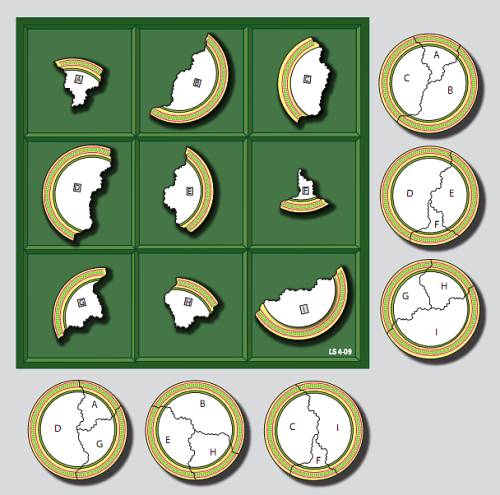scoteography
n. the art of writing in the dark
Author: Greg Ross
Husbands and Wives
This problem dates from at least 1774; this version appeared in the American Mathematical Monthly of December 1902:
Three Dutchmen and their wives went to market to buy hogs. The names of the men were Hans, Klaus, and Hendricks, and of the women, Gertrude, Anna, and Katrine; but it was not known which was the wife of each man. They each bought as many hogs as each man or woman paid shillings for each hog, and each man spent three guineas more than his wife. Hendricks bought 23 hogs more than Gertrude, and Klaus bought 11 more than Katrine. What was the name of each man’s wife?
(There are 21 shillings in a guinea.)
Retrieval Error
An English professor was training her students in memorization techniques.
“For instance,” she said, “if you want to remember the name of a certain poet, Bobbie Burns, you could visualize a London policeman in flames.” She drew a picture in chalk. “You see? ‘Bobbie Burns.'”
A student raised his hand and asked, “How could we know that’s not ‘Robert Browning’?”
Risqué Business

In 1969, convinced that anything prurient would sell in the era of Harold Robbins and Jacqueline Susann, Newsday columnist Mike McGrady decided to manufacture his own bestseller. He asked 24 colleagues to write a chapter apiece, following two rules: They had to write badly, and there had to be an “unremitting emphasis on sex”:
In the darkened room, now thirstier than ever, Gillian was suddenly aware of the presence beside her of Mario Vella. He had allowed his left elbow to brush gently against her. In any other surrounding, in any other circumstances, Gillian Blake would have gracefully withdrawn. She didn’t. She held her ground and his elbow became more persistent.
Sadly, McGrady was right. With two sex scenes per chapter, Naked Came the Stranger quickly became a national bestseller, ending the year at number 7 on the fiction charts, five slots behind The Godfather.
“Penelope Ashe’s scorching novel makes Portnoy’s Complaint and Valley of the Dolls read like Rebecca of Sunnybrook Farm,” wrote the Long Island Press. And the Asheville, N.C., Citizen-Times said it was “witty and written in good taste, and brings out many new angles in man-woman relationships.”
“These are the kind of people,” McGrady told Life, “who are running around setting literary standards.”
The Knobe Effect
The vice president of a company went to the chairman of the board and said, ‘We are thinking of starting a new program. It will help us increase profits, but it will also harm the environment.’ The chairman of the board answered, ‘I don’t care at all about harming the environment. I just want to make as much profit as I can. Let’s start the new program.’ They started the new program. Sure enough, the environment was harmed.
Did the chairman harm the environment intentionally? In a 2003 study, 82 percent of respondents said yes, he did. But now consider this:
The vice president of a company went to the chairman of the board and said, ‘We are thinking of starting a new program. It will help us increase profits, and it will also help the environment.’ The chairman of the board answered, ‘I don’t care at all about helping the environment. I just want to make as much profit as I can. Let’s start the new program.’ They started the new program. Sure enough, the environment was helped.
Did the chairman help the environment intentionally? Only 23 percent of respondents said yes.
What should we make of this? Yale philosopher Joshua Knobe says, “It seems very puzzling that all we changed was this one word, just changing the word harm to help, and yet we’re now having completely different judgments about whether what he did was intentional or unintentional. Yet it seems like it’s only the moral status of what he did that is changing. … Somehow the moral judgments people are making are affecting their intuitions about something like how the mind works.”
“A Chronicle”
Once — but no matter when —
There lived — no matter where —
A man whose name — but then
I need not that declare.
He — well, he had been born,
And so he was alive;
His age — I details scorn —
Was somethingty and five.
He lived — how many years
I truly can’t decide;
But this one fact appears
He lived — until he died.
“He died,” I have averred,
But cannot prove ’twas so,
But that he was interred,
At any rate, I know.
I fancy he’d a son,
I hear he had a wife:
Perhaps he’d more than one,
I know not, on my life!
But whether he was rich,
Or whether he was poor,
Or neither — both — or which,
I cannot say, I’m sure.
I can’t recall his name,
Or what he used to do:
But then — well, such is fame!
‘Twill so serve me and you.
And that is why I thus,
About this unknown man
Would fain create a fuss,
To rescue, if I can,
From dark oblivion’s blow,
Some record of his lot:
But, ah! I do not know
Who — where — when — why — or what.
MORAL
In this brief pedigree
A moral we should find —
But what it ought to be
Has quite escaped my mind!
— William T. Dobson, Literary Frivolities, Fancies, Follies and Frolics, 1880
“The Archaeologist’s Nightmare”
From Lee Sallows, a geometric magic square:

The shards in each row and column produce a complete plate.
So do the diagonals!
Tight Squeeze
By T.R. Dowson. White to mate in 21 moves:

It’s not as hard as it sounds, though it’s a bit like a square dance in a submarine.
Bank Balance
‘Well, then, good fellow, holy father, or whatever thou art,’ quoth Robin, ‘I would know whether this same Friar is to be found upon this side of the river or the other.’
‘Truly, the river hath no side but the other,’ said the Friar.
‘How dost thou prove that?’ asked Robin.
‘Why, thus,’ said the Friar, noting the points upon his fingers. ‘The other side of the river is the other, thou grantest?’
‘Yea, truly.’
‘Yet the other side is but one side, thou dost mark?’
‘No man could gainsay that,’ said Robin.
‘Then if the other side is one side, this side is the other side. But the other side is the other side, therefore both sides of the river are the other side. Q.E.D.’
”Tis well and pleasantly argued,’ quoth Robin, ‘yet I am still in the dark as to whether this same Curtal Friar is upon the side of the river on which we stand or upon the side of the river on which we do not stand.’
‘That,’ quoth the Friar, ‘is a practical question upon which the cunning rules appertaining to logic touch not. I do advise thee to find that out by the aid of thine own five senses; sight, feeling, and what not.’
— Howard Pyle, The Merry Adventures of Robin Hood, 1883
The Price

Aristippus passed Diogenes as he was washing lentils.
He said, “If you could but learn to flatter the king, you would not have to live on lentils.”
Diogenes said, “And if you could learn to live on lentils, you would not have to flatter the king.”

